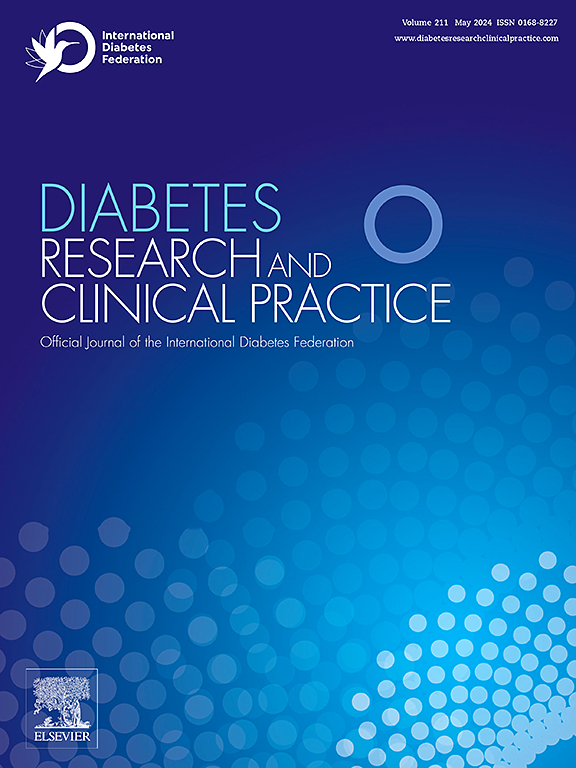糖尿病足:撒哈拉以南非洲地区糖尿病患者患病率及相关因素的系统回顾和荟萃分析。
IF 6.1
3区 医学
Q1 ENDOCRINOLOGY & METABOLISM
引用次数: 0
摘要
背景:糖尿病是非传染性疾病之一,是撒哈拉以南非洲最大的公共卫生挑战,在那里,与糖尿病相关的需求目前在很大程度上没有得到满足,与医疗费用、自我保健做法和知识不足有关的问题使足部衰弱方面恶化。为了估计糖尿病患者中糖尿病足溃疡的总患病率和相关因素,我们进行了系统回顾和荟萃分析。虽然已有关于糖尿病患者糖尿病足溃疡的研究,但结果并不一致。目的:确定撒哈拉以南非洲地区糖尿病患者糖尿病足溃疡的总患病率及相关因素。方法:根据系统评价和荟萃分析的首选报告项目指南进行系统评价和荟萃分析。为了确定2024年5月29日之前发表的英文论文,检索了Medline、Science Direct、摘录医学数据库、Cochrane Library、African Journals Online和谷歌Scholar等电子数据库。随机效应模型的DerSimonian和Laird方法用于估计糖尿病足溃疡的总患病率。为了检验研究和发表偏倚之间的异质性,分别使用森林图和漏斗图。结果:本系统综述和荟萃分析共纳入了28项研究,涉及10635名受试者。糖尿病患者中糖尿病足溃疡的总患病率为13.35% (95% CI 10.86, 15.67)。农村居住(OR = 3.25, 95% CI = 2.15-4.99)、周围神经病变(OR = 5.89, 95% CI = 2.5-13.5)、自我保健不良(OR = 2.39, 95% CI = 1.12-5.13)、病程大于10年(OR = 2.94, 95% CI = 1.14, 7.63)、溃疡史(OR = 6.07, 95% CI = 1.68-21.9)与糖尿病足溃疡显著相关。结论:撒哈拉以南非洲地区糖尿病足溃疡患病率较高。因此,应重视预防、定期足部检查和早期识别危险因素。本文章由计算机程序翻译,如有差异,请以英文原文为准。
Diabetic foot: A systematic review and meta-analysis on its prevalence and associated factors among patients with diabetes mellitus in a sub-Saharan Africa
Background
Diabetes is one of the non-communicable diseases that represents the greatest public health challenge in sub-Saharan Africa, where diabetes related needs are currently largely unmet, and the debilitating aspects of the foot are worsened by issues related to healthcare costs, self-care practices, and inadequate knowledge. To estimate the pooled prevalence and associated factors of diabetic foot ulcers among patients with Diabetes mellitus, we conducted a systematic review and meta-analysis. Although studies on, diabetic foot ulcer among patients with diabetes mellitus have been available, the results have been inconsistent.
Objectives
To determine the pooled prevalence and associated factors of diabetic foot ulcers among patients with diabetes mellitus in sub-Saharan Africa.
Methods
A systematic review and meta-analysis was conducted in accordance with the Preferred Reporting Items for Systematic Reviews and Meta-Analyses guideline. To identify papers published in English up to May 29, 2024, the electronic databases of Medline, Science Direct, Excerpta Medica Database, Cochrane Library, African Journals Online, and Google Scholar were searched. The DerSimonian and Laird method for random-effects models was used to estimate the pooled prevalence of diabetic foot ulcers. To test for heterogeneity between studies and publication bias, forest plots and funnel plots were, respectively used.
Results
A total of 28 studies with 10,635 participants were included in this systematic review and meta-analysis. The pooled prevalence of diabetic foot ulcer among patients with diabetes mellitus was 13.35 % (95 % CI 10.86, 15.67). Rural residence (OR = 3.25, 95 % CI = 2.15–4.99), peripheral neuropathy (OR = 5.89, 95 % CI = 2.5–13.5), poor self-care practice (OR = 2.39, 95 % CI = 1.12–5.13), illness duration greater than 10 years (OR = 2.94, 95 % CI = 1.14, 7.63), and history of ulcer (OR = 6.07, 95 % CI = 1.68–21.9) were significantly associated with diabetic foot ulcers.
Conclusion
Sub-Saharan Africa has a high prevalence of diabetic foot ulcers. Thus, emphasis should be given to Prevention, periodic foot examination, and early identification of risk factors.
求助全文
通过发布文献求助,成功后即可免费获取论文全文。
去求助
来源期刊

Diabetes research and clinical practice
医学-内分泌学与代谢
CiteScore
10.30
自引率
3.90%
发文量
862
审稿时长
32 days
期刊介绍:
Diabetes Research and Clinical Practice is an international journal for health-care providers and clinically oriented researchers that publishes high-quality original research articles and expert reviews in diabetes and related areas. The role of the journal is to provide a venue for dissemination of knowledge and discussion of topics related to diabetes clinical research and patient care. Topics of focus include translational science, genetics, immunology, nutrition, psychosocial research, epidemiology, prevention, socio-economic research, complications, new treatments, technologies and therapy.
 求助内容:
求助内容: 应助结果提醒方式:
应助结果提醒方式:


